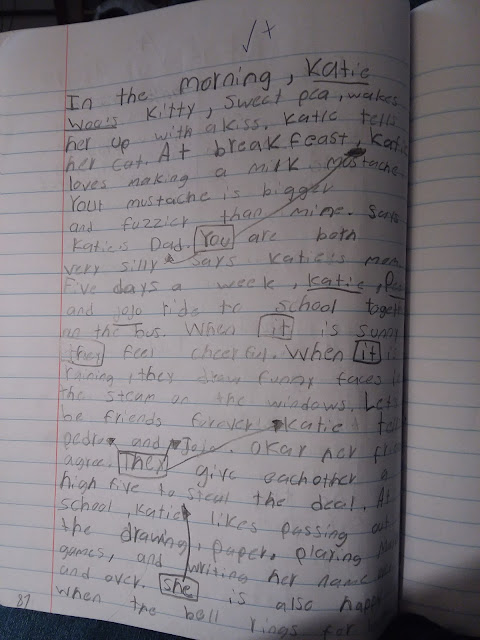I have been working with my students on tracing pronouns back to the antecedent. We have studied subjective, objective, posssessive, and reflexive pronouns. I wanted them to be able to identify the different pronouns and to understand the function. Understanding pronouns requires a knowledge of their cousins, the nouns. We could even say, their parents. In order to understand a pronoun, you would need to know that the pronouns takes the place of a noun. The nouns should be written first and then the pronoun can be introduced. If that is not the case, then we have a vague pronoun reference. When I introduced this, I talked to my students about how my mother always uses a vague pronoun reference. My mother, with our many conversations, says, "Well, you know that they say that you should drink more coffee. They say coffee is good for you." That always drives me crazy. I always ask, "Mom, who are they?" That question always gets her angry. She gives me the frustrated look and states, "You know. The doctors!" I then reply, "No, Mom. I didn't know because you didn't first state who they were. You were vague." I let the students know that their job as writers is to be clear to the reader. To be clear, the reader has to be able to see what you are talking about. When we start with the pronoun, the reader become blind. I then introduce subjective pronouns. We then read mentor paragraphs from articles and books where the antecedent (noun) is introduced primarily. Then we find the pronoun in the same sentence or in the next sentences. I teach them to trace the pronouns back to the antecedent. As I had taught them previously, we code the singularity and plurality of the nouns and pronouns by coding them (1)(one) and (+1)(more than one).(This idea was adapted from Gretchen Bernabei's
Grammar Keepers.) I discuss how they should agree or if not the reader will be confused. I love teaching this. I have included some photos of their work.
First, I teach them the academic terms like antecedent and then we move onto subjective pronouns. (This idea came from Jeff Anderson's book
Mechanically Inclined.) Throughout the next two week, I introduce objective pronouns, possessive, and reflexive pronouns.
We find the pronouns, trace them back to the antecedents, code the antecedent and pronouns, finally we code them to check for agreement. We do this through the use of mentor text and editing invitations taken from the research of Jeff Anderson's
Editing Invitations and
Mechanically Inclined.
I show them published examples paragraphs from published text. We discuss what we notice and trace the pronouns back to the antecedent. Then I have them try writing sentences where they first mention a noun and then continue with other sentences using pronouns. I show them how to do this with my own writing and by imitating previously studied mentor text. They write their antecedents and pronouns in their notebooks and on sentence strips. Finally, they are invited to collect (Invitation to Collect) examples that they find in books and articles. My students do this with a partner. They write examples in their notebooks and are prepared to share with other partners and the class.
I have included some photos of their work and other coding that they have done with nouns. I hope you find this helpful.




















No comments:
Post a Comment